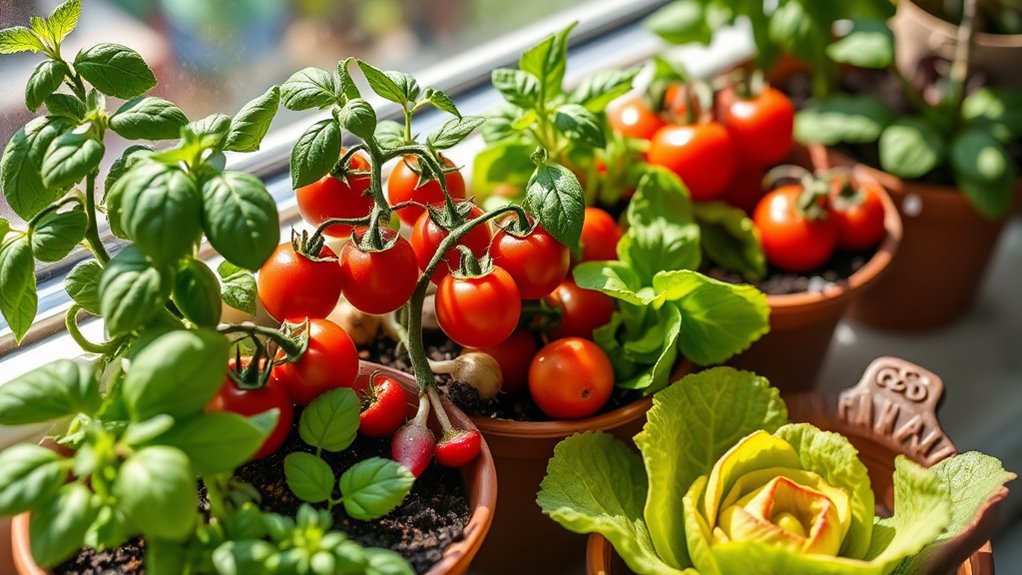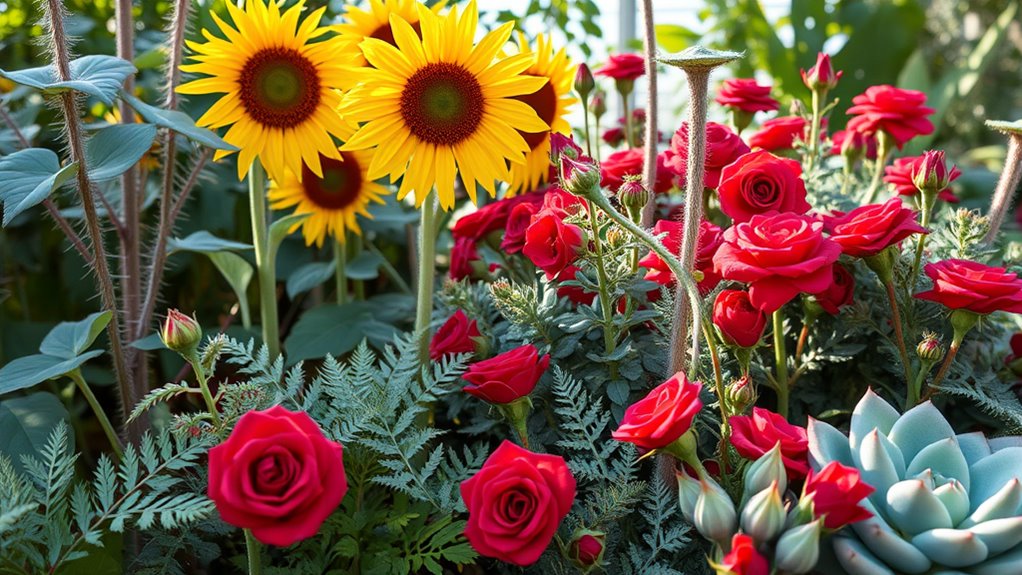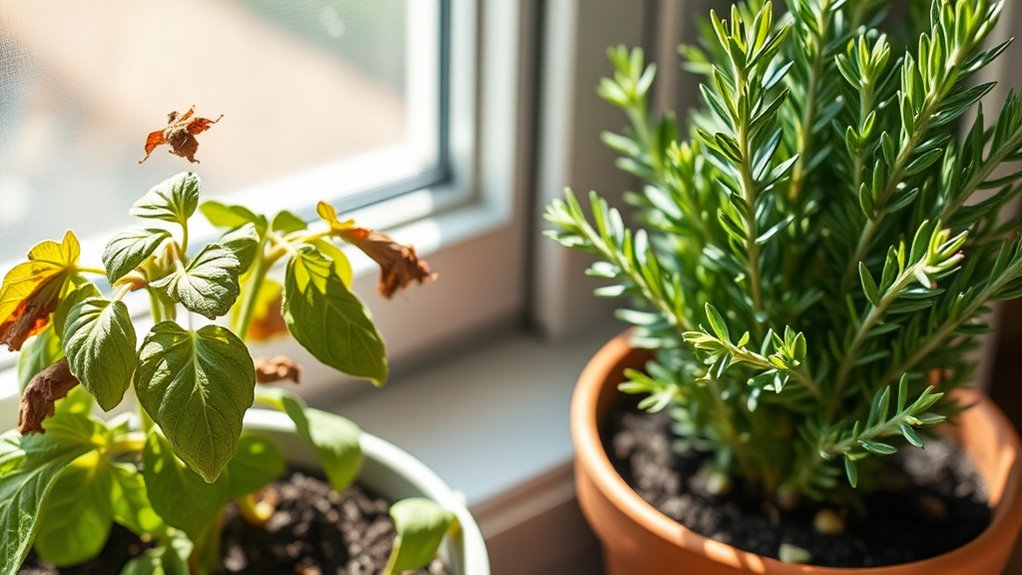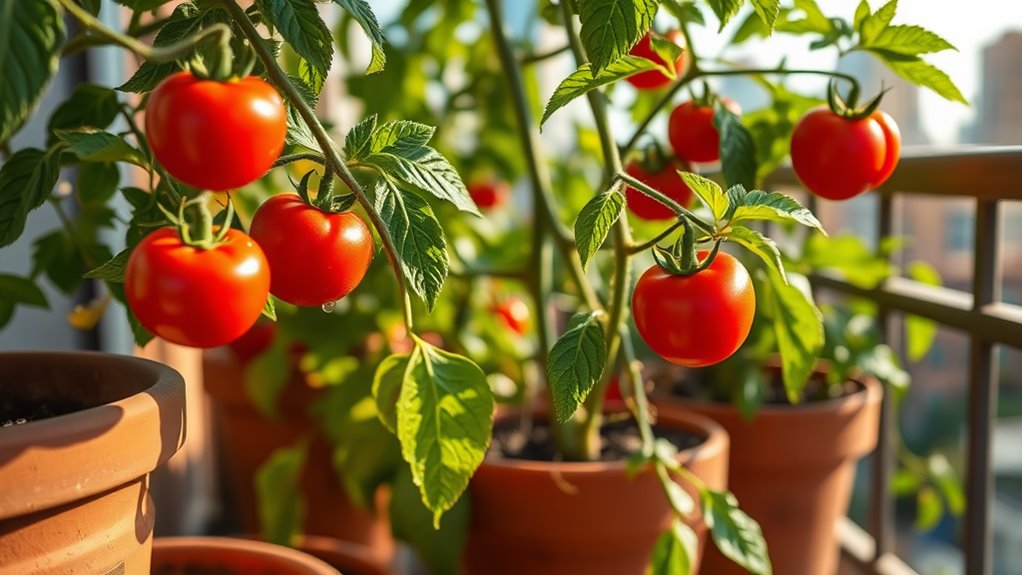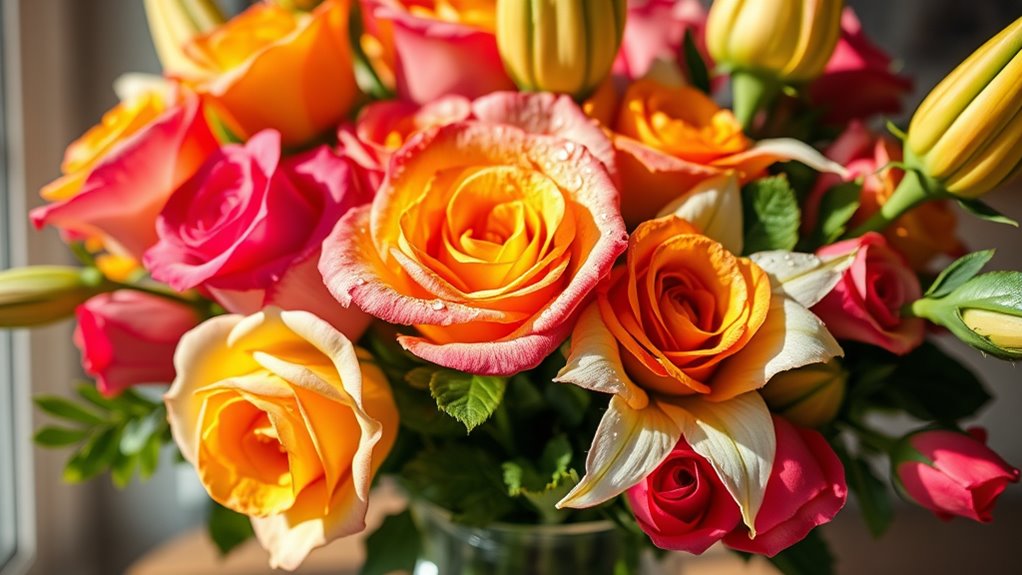The Best Veggies to Grow for a Super Small Garden
For your super small garden, you’ll love growing compact tomatoes, space-saving lettuce, and quick-maturing radishes—they fit neatly in pots or vertical setups and thrive with well-drained soil and ample sun. Bush beans and dwarf cucumbers deliver high yields with minimal care, while container carrots add variety without taking up room. Stick around for tips on optimizing these choices to boost your harvest.
Key Takeaways
- Grow compact tomato varieties like ‘Patio’ in 5-gallon pots for small spaces.
- Choose dwarf cucumber options such as ‘Bush Pickle’ for high yields in containers.
- Select space-saving lettuce like ‘Salanova’ for quick harvests in tight areas.
- Plant radishes for fast maturation in 3-4 weeks with minimal space needed.
- Use bush beans in small pots, as they thrive with 6-12 inch spacing.
Compact Tomato Varieties
If you’re gardening in a small space, compact tomato varieties offer an easy way to grow fresh produce without overwhelming your area.
As part of compact vegetable options, these include determinate types that grow to a compact 3-4 feet, ideal for pots or balconies. You choose varieties like ‘Patio’ or ‘Tiny Tim’ for quick maturation and high yields in limited soil.
Plant them in at least 5-gallon containers with well-drained soil, ensuring 6-8 hours of sunlight daily. Water consistently to avoid issues like blossom end rot, and use stakes for support. For beginners, proper soil preparation is essential to promote healthy root development and overall plant vitality.
This approach maximizes space while delivering fresh, nutritious tomatoes efficiently.
These compact tomato varieties exemplify easy-to-care-for plants that help maximize space and yield delicious produce in tiny garden areas.
Space-Saving Lettuce Options
Transitioning from tomatoes, you’ll find space-saving lettuce varieties perfect for small gardens, as they mature quickly in compact spaces like pots or window boxes.
These options maximize your limited area while providing fresh greens. For optimal results, focus on varieties that promote efficiency and health. Additionally, for a diverse and effortless garden setup, consider combining these lettuces with low-maintenance herbs to enhance resilience and yield.
-
Choose loose-leaf types, like ‘Salanova’, for their rapid regrowth and shallow root systems, allowing dense planting.
-
Prioritize quick-maturing cultivars****, such as ‘Black-Seeded Simpson’, which reach harvest in 45-60 days under full sun.
-
Incorporate vertical growth methods****, such as hanging baskets, to utilize unused air space effectively.
-
Ensure nutrient-rich soil****, with balanced NPK fertilizers, to support photosynthesis and prevent bolting in confined environments.
To further boost soil fertility and sustainability, incorporate organic composting with kitchen scraps and garden waste for healthier plant growth.
Easy Radish Growing
You sow radish seeds directly into your garden’s soil, spacing them about an inch apart for optimal growth in tight spaces.
As the plants mature in just 3-4 weeks, you harvest fresh radishes by gently pulling them when they’re firm and about an inch wide.
This simple process yields crisp, nutritious roots that enhance your small garden’s productivity.
Sowing Radish Seeds
Sowing radish seeds is a simple process that rewards beginners with fast results.
You’ll select a sunny spot with well-drained soil, aiming for a pH of 6.0 to 7.0 to optimize nutrient uptake and prevent diseases. As a cool-season crop, sow in early spring or fall for best germination.
To sow properly:
– Till soil to 6 inches deep and amend with compost for improved fertility.
– Plant seeds 1/2 inch deep, spacing them 1 inch apart in rows.
– Water gently immediately after to ensure even moisture without erosion.
– Monitor soil temperature, ideally 45-70°F, for quick sprouting.
This approach minimizes risks and promotes vigorous early growth.
Harvesting Fresh Radishes
Once radishes form firm, round bulbs about 1 inch in diameter, harvest them early in the morning for peak crispness and flavor. This timing reduces transpiration, preserving moisture and nutrients in the roots.
Use a hand fork to gently loosen soil around the base, then grasp leaves near the crown and pull steadily to avoid damage. Rinse harvested radishes under cool running water to remove soil and debris, then pat dry with a clean cloth.
Store in the refrigerator’s crisper at 32-40°F in a perforated bag; they’ll retain freshness for up to two weeks. For continuous yield, monitor plants daily and harvest promptly to prevent bolting, which causes bitterness.
Rotate crops to manage pests effectively.
Vertical Herb Gardens
Vertical herb gardens maximize limited space by stacking plants upward, making them ideal for small gardens where horizontal room is scarce. You can grow herbs like basil, thyme, and oregano vertically, boosting yields while minimizing footprint. Additionally, these gardens allow you to cultivate flavorful herbs that enhance your meals with their delicious tastes.
This method enhances air circulation and light exposure, promoting healthier growth through efficient resource use.
-
Select compact herbs****: Choose varieties with shallow roots, such as chives or parsley, for better stability in stacked setups.
-
Optimize sunlight: Position your garden to receive 6-8 hours of direct sun daily, ensuring photosynthesis rates remain high.
-
Ensure drainage: Use pots with drainage holes and well-aerated soil mixes to prevent waterlogging and fungal issues.
-
Monitor moisture: Test soil regularly with a moisture meter to maintain ideal hydration levels for robust herb development.
By adopting this setup, you can achieve indoor herb growing for fresh, flavorful herbs year-round without the need to purchase them.
Mini Pepper Plants
Mini pepper plants thrive in small gardens, building on the space-saving strategies of vertical herbs by fitting neatly into pots or raised beds. Additionally, to handle unpredictable weather, these plants can be protected with strategies like those used in seasonal gardening to safeguard crops.
You can choose compact varieties like bell or jalapeño peppers, which produce high yields in limited space. They’re sun-loving, requiring at least six hours of direct light daily for optimal fruiting.
Plant them in well-draining soil with a pH of 6.0-7.0, and water consistently to keep soil moist but not soggy.
Watch for pests like aphids; use natural controls such as neem oil.
You’ll harvest fresh, vitamin-rich peppers in just 60-90 days, boosting your meals with flavor and nutrition.
For optimal hydration, incorporate expert watering techniques to avoid common mistakes and promote healthy plant growth.
Bush Beans for Small Areas
You can grow bush beans in your small garden by starting with their ideal spacing of about 6-12 inches between plants to optimize space.
Consider container options like 5-gallon pots or window boxes, which make them perfect for patios or balconies.
Their quick maturation in 50-60 days lets you enjoy fresh beans sooner than many other veggies.
Ideal Spacing
When growing bush beans in limited spaces, proper spacing promotes healthy plants and maximizes yields. You’ll enhance air circulation, reduce disease risk, and optimize nutrient uptake, ensuring robust growth and higher productivity in tight areas.
-
Space plants 4-6 inches apart to minimize competition for sunlight and water, fostering strong root development.
-
Keep rows 18-24 inches apart for better airflow, which scientifically lowers fungal infection rates.
-
Ensure even spacing to promote uniform maturation, allowing each plant to photosynthesize efficiently.
-
Monitor spacing based on soil type, adjusting to prevent stunting and support maximum bean production.
Container Options
For growing bush beans in small areas, choosing the right containers boosts productivity and space efficiency. You’ll need ones that support root health and maximize vertical space, like pots with drainage holes and sturdy bases. Select materials that retain moisture without waterlogging, ensuring optimal soil aeration for vigorous growth.
| Container Type | Recommended Size | Key Benefits |
|---|---|---|
| Plastic Pots | 8-12 inches deep | Lightweight, affordable, easy to move |
| Fabric Grow Bags | 10-15 inches wide | Excellent drainage, promotes air pruning |
| Ceramic Pots | 9-14 inches diameter | Stable, retains moisture, adds aesthetic appeal |
Quick Maturation
Bush beans thrive in small areas due to their rapid maturation, often ready for harvest in as little as 50 to 60 days from planting. This quick cycle allows multiple harvests per season, making them ideal for urban settings where space and time are constraints.
Scientifically, their nitrogen-fixing roots enhance soil fertility, supporting sustainable gardening.
- Choose compact, disease-resistant varieties like ‘Provider’ for faster growth.
- Plant in well-drained, nutrient-rich soil with pH 6.0-7.0 for optimal germination.
- Maintain even watering to prevent stress, aiming for 1 inch weekly.
- Harvest regularly when pods reach 4-6 inches to promote continuous production.
Container Carrots
Growing carrots in containers lets you maximize limited garden space while enjoying a fresh, nutrient-rich harvest. You’ll select compact varieties that thrive in shallow soil, ensuring at least 12 inches of depth for optimal root development. Use well-draining, pH-balanced soil to avoid diseases, and water evenly to maintain moisture without sogginess. For the best outcomes, start with universal soil prep methods to tailor the soil to your specific environment. Additionally, prioritize soil preparation to ensure your containers have nutrient-rich soil that supports healthy root development.
| Variety | Key Benefits |
|---|---|
| Thumbelina | Extremely short roots |
| Parisian | Round shape for pots |
| Nantes | Sweet, crisp flavor |
| Chantenay | Resilient in containers |
Harvest when carrots reach full color for maximum nutrients.
Dwarf Cucumber Choices
Dwarf cucumbers provide ideal choices for compact gardens, letting you grow flavorful varieties in limited spaces.
You’ll enjoy high yields from these bushy plants, which thrive in containers with minimal support. They resist common diseases and mature quickly, making them perfect for small-scale gardening.
-
Select compact varieties like ‘Bush Pickle’ for its disease resistance and productivity.
-
Monitor soil moisture to maintain even hydration, preventing bitterness in fruits.
-
Provide full sun**** exposure, as these cultivars need at least 6 hours daily for optimal photosynthesis.
-
Prune lightly to control growth and boost air circulation, reducing fungal risks.

